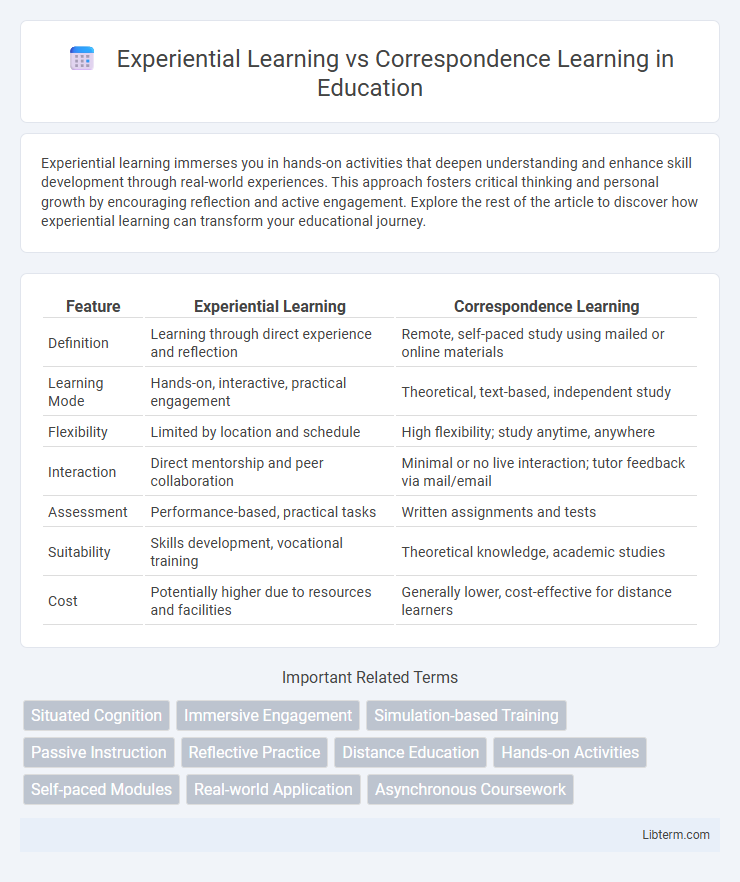Experiential learning immerses you in hands-on activities that deepen understanding and enhance skill development through real-world experiences. This approach fosters critical thinking and personal growth by encouraging reflection and active engagement. Explore the rest of the article to discover how experiential learning can transform your educational journey.
Table of Comparison
| Feature | Experiential Learning | Correspondence Learning |
|---|---|---|
| Definition | Learning through direct experience and reflection | Remote, self-paced study using mailed or online materials |
| Learning Mode | Hands-on, interactive, practical engagement | Theoretical, text-based, independent study |
| Flexibility | Limited by location and schedule | High flexibility; study anytime, anywhere |
| Interaction | Direct mentorship and peer collaboration | Minimal or no live interaction; tutor feedback via mail/email |
| Assessment | Performance-based, practical tasks | Written assignments and tests |
| Suitability | Skills development, vocational training | Theoretical knowledge, academic studies |
| Cost | Potentially higher due to resources and facilities | Generally lower, cost-effective for distance learners |
Introduction to Experiential Learning and Correspondence Learning
Experiential Learning emphasizes hands-on, real-world experiences where learners actively engage in tasks to acquire knowledge, fostering deeper understanding and skill development. Correspondence Learning delivers educational content remotely, allowing learners to study independently through mailed or digital materials, emphasizing flexibility and self-paced progress. Both methods cater to distinct learning needs, with experiential approaches promoting practical application and correspondence focusing on accessibility and convenience.
Defining Experiential Learning
Experiential learning is defined as a hands-on educational approach that emphasizes learning through direct experience, reflection, and application, allowing learners to actively engage with real-world situations. This method contrasts with correspondence learning, which relies on remote, often self-paced study through mailed or online materials without immediate interaction or practical engagement. The core principle of experiential learning centers on developing skills and knowledge through tangible activities and critical thinking rather than passive receipt of information.
Understanding Correspondence Learning
Correspondence learning is a method of education where students receive instructional materials and assignments remotely, allowing them to study at their own pace without direct, real-time interaction with instructors. This learning model emphasizes self-discipline, written communication, and independent problem-solving skills due to the lack of immediate feedback and face-to-face engagement. Understanding correspondence learning involves recognizing its reliance on structured educational resources, flexibility for learners with scheduling constraints, and challenges related to limited experiential activities compared to experiential learning methodologies.
Key Differences Between Experiential and Correspondence Learning
Experiential learning emphasizes hands-on, immersive activities that foster practical skills and real-world problem-solving, while correspondence learning relies on remote, self-paced study through written materials and assignments. Key differences include the mode of engagement, with experiential learning offering direct interaction and immediate feedback, compared to correspondence learning's asynchronous communication and limited instructor presence. Furthermore, experiential learning promotes active participation and collaboration, whereas correspondence learning is often solitary and dependent on learners' self-motivation and time management.
Advantages of Experiential Learning
Experiential learning fosters deep understanding by engaging learners in real-world tasks and hands-on activities, enhancing retention and practical skill development. It promotes critical thinking and problem-solving abilities through active participation rather than passive information reception. This approach also encourages adaptability and personal growth by immersing students in dynamic, authentic learning environments.
Benefits of Correspondence Learning
Correspondence learning offers flexible access to education, allowing students to study at their own pace and from any location, which is ideal for working professionals and those with geographic constraints. It reduces costs associated with commuting and accommodation, making higher learning more affordable and accessible. This mode of learning also fosters self-discipline and time management skills as learners take responsibility for their educational progress independently.
Challenges and Limitations of Both Approaches
Experiential learning often faces challenges such as limited scalability and high resource demands, making it difficult to implement consistently across large or remote populations. Correspondence learning struggles with lack of immediate feedback and reduced learner engagement, which can hinder comprehension and skill retention. Both approaches require tailored strategies to address their inherent limitations in order to optimize educational outcomes.
Contexts Best Suited for Experiential Learning
Experiential learning excels in hands-on environments such as internships, laboratory work, and vocational training where direct engagement with materials or real-world scenarios enhances skill acquisition. This approach is particularly effective in fields like healthcare, engineering, and education, where practical application and reflection on experiences deepen understanding and competence. Contexts requiring problem-solving, critical thinking, and collaborative teamwork benefit significantly from experiential methods compared to correspondence learning.
When to Choose Correspondence Learning
Correspondence learning is ideal for students needing flexible schedules, allowing them to study remotely without fixed class times. It suits individuals balancing work, family, or geographic constraints that prevent on-campus attendance. This mode emphasizes self-paced, independent study, making it effective when practical experience or direct interaction is less critical.
Conclusion: Choosing the Right Learning Method
Experiential learning offers hands-on engagement and practical skill development, making it ideal for subjects requiring real-world application, while correspondence learning provides flexibility and accessibility, suitable for self-motivated learners or those with time constraints. Selecting the right method depends on individual learning preferences, career goals, and the nature of the subject matter. Evaluating factors such as interaction level, schedule flexibility, and desired outcomes ensures a tailored educational experience that maximizes knowledge retention and skill acquisition.
Experiential Learning Infographic

 libterm.com
libterm.com